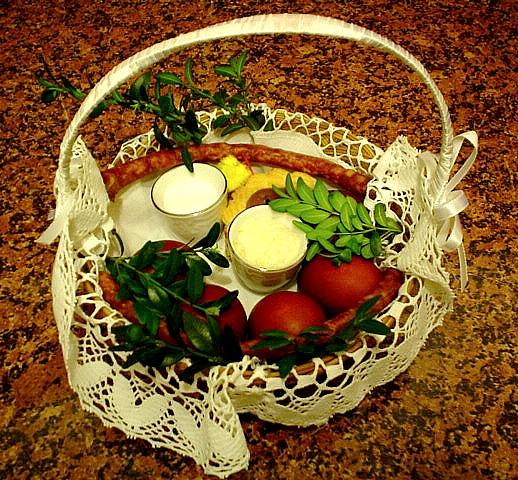What to put in a traditional Polish Easter Basket? Posted by Kasia on Apr 14, 2017 in Culture
Easter is almost here! On Holy Saturday (Wielka Sobota) every Polish household prepares an Easter basket (święconka) which is full of goods that will be eaten on Easter breakfast – the most celebrated Easter meal in Polish culture. In the basket there is usually some bread, eggs, ham, lamb-shaped cake, sausages, salt, horseradish, ćwikła and nowadays also chocolate. The baskets are decorated with white serviettes and flowers or willow branches. They are taken to church to be blessed by the priest who uses an aspergillum (kropidło – little brush that’s dipped in holy water) and sprinkles holy water over people’s heads and Easter baskets. This tradition dates back to the 7th century.
Traditions vary from village to village and family to family. They have changed and evolved with each passing generation. Food can be blessed at the church or at home. I have heard different stories, where people say that “only rich people had their baskets blessed at home”. I remember it a little different. My family lived far away from the church. For that reason, my grandparents invited closest family and neighbors to bring their baskets to their house and then priest visited my grandparents house for the blessing of the baskets.
After the blessing, the food is usually set aside until Easter morning when the head of the house shares the blessed egg, symbol of life, with his family and friends. Having exchanged wishes, all continue to enjoy a hearty meal.
Each of the foods which traditionally makes up the Easter basket has a deep and symbolic meaning:
Masło (butter) This favourite dairy product is often shaped into a lamb (Baranek Wielkanocny) or a cross. This reminds us of the goodness of Christ that we should have toward all things.
Babka (Easter bread) – A round loaf topped with a cross or a fish, symbolic of Jesus, who is our true Bread of Life.
Chrzan (horseradish often with grated red beets) – Symbolic of the Passion of Christ still in our minds but sweetened with some sugar because of the Resurrection.
Jajka (eggs) – Eggs were always considered as a symbol of the resurrection, the emergence of a new life. At Easter our Saviour came forth from the tomb as the chick after breaking the shell at birth. Because of this special meaning, it is fitting that Easter eggs be coloured or decorated (often with the symbols of Easter, of life, of prosperity). They are the favoured object of our national art and are known to us as “pisanki.”
Kiełbasa (sausage) – A spicy sausage of pork products, indicative of God’s favour and generosity.
Szynka (ham) – Symbolic of great joy and abundance. Some prefer lamb or veal. The lamb also reminds Catholics that the Risen Christ is the ‘Lamb of God.”
Słonina (smoked bacon) – A symbol of the overabundance of God’s mercy and generosity.
Sól (salt) – So necessary an element in our physical life, that Jesus used its symbolism: “You are the salt of the earth.”
Ser (Cheese): Symbolic of the moderation Christians should have at all times.
Świeczka (candle): Represents Christ as the Light of the World.
Colorful ribbons and sprigs of greenery: Attached to the basket as signs of joy and new life in the season of spring and in celebration of the resurrection.
Linen/Crochet Cover: Drawn over the top of the basket which is ready for the priest’s visit to the home or the trip to church where it is joined with the baskets of others to await the blessing

Build vocabulary, practice pronunciation, and more with Transparent Language Online. Available anytime, anywhere, on any device.




